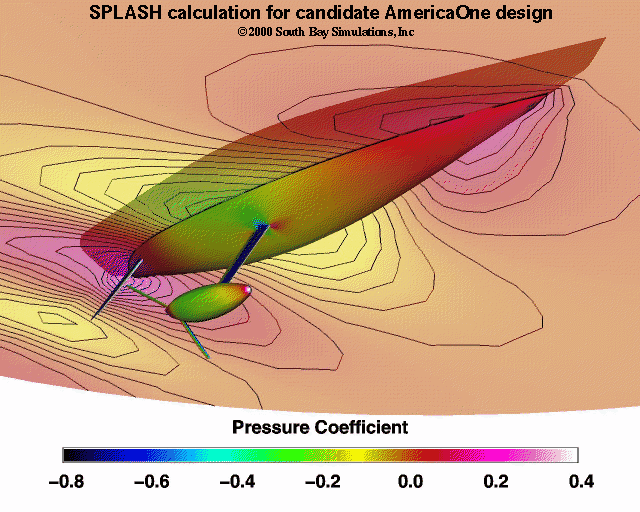

AmericaOne uses SPLASH in America's Cup Design Process
AmericaOne decided early in its program to make aggressive use of computer simulation to improve and accelerate the yacht design process. A key ingredient in the effort was their use of the SPLASH free-surface code. It is the world's most highly developed, mature and reliable flow simulation package available today, at least as far as the underwater part of the yacht design equation is concerned.
Several AmericaOne design team members had experience with SPLASH from previous Cup programs, and pushed hard to ensure that AmericaOne would have access to it as well. The code was developed by Bruce Rosen, president of South Bay Simulations, Inc. of Babylon, NY. AmericaOne enlisted the services of Dr. Warren Davis to run the code for the team. By day, Rosen and Dr. Davis work together closely at Northrop Grumman, applying their CFD (computational fluid dynamics) and applied aerodynamics skills to military aircraft design.
SPLASH is a free-surface potential flow panel code, one of the few tools able to account simultaneously for the various physical aspects of the underwater flow field. Hull, keel, bulb, rudder, wing and wave surfaces are all modeled with a high degree of fidelity, so the simulations can be used to accurately predict many important aspects of yacht performance. The code's nonlinear sink, trim, and free-surface shape are critical.
First, there is wave drag, the energy lost to wave generation as the model moves through the water. Next, there is lift-induced drag, a result of the energy lost in the trailing vortices shed by the appendages as they generate the side force to counteract the sails. Finally, there is viscous or skin friction drag.
Being a potential flow code, SPLASH cannot model the viscous drag directly. But with its nonlinear capabilities it produces reliable wetted hull wetted areas, appendage spanloads, and other prediction details, so as to provide a strong basis for more accurate viscous drag estimates. AmericaOne even ran final SPLASH-generated hull + free surface wave geometries through the more-difficult-to-use viscous (Navier-Stokes) flow solvers. This approach allowed the free-surface waves to be included in the viscous simulations, to better study the effect of subtle hull shaping on hull boundary layer and viscous drag characteristics.
SPLASH's unsteady capabilities were also used, to predict seakeeping and performance in waves. Unsteady yacht motions and added resistance in waves were predicted for the appended hull models. A complete six degree-of-freedom motions capability was available, including heel, yaw, tab and rudder deflections, for arbitrary incident wave lengths and headings. Both steady and unsteady SPLASH simulations were brought to bear for the AmericaOne design effort.
During past Cup efforts, and this time around, the ability to analyze hundreds of yacht models in the computer instead of in the tank belongs to SPLASH. The code not only provides accurate and reliable results, it also runs very quickly, in just a fraction of the time of a viscous flow solver, and it requires much less computer resources. It is possible to run complete SPLASH model tests, with 100-200 test points, in just 12 hours using only a mid-range desktop UNIX workstation. Here, each test point is a distinct setting of forward speed, and heel, yaw, tab and rudder angles, just as in a real towing tank test.
AmericaOne designers were able to establish electronic file transfer protocols to virtually automate the entire numerical model testing and performance analysis. Designs moved directly from the designers' 3-D CAD (computer aided design) software to SPLASH numerical tank testing and, from there, to a final VPP (Velocity Prediction Program) to complete the simulation process on the total configuration in real sailing conditions.
With this approach, AmericaOne was able to greatly accelerate the yacht design process. SPLASH was used to numerically screen a large number of candidate models, prior to checking in at the real towing tank, where tests are one to two orders of magnitude more expensive and time consuming. And physical towing tank tests are by themselves a very difficult technical undertaking. It was a big advantage to go into the tank with computer predictions in hand, to have a good idea of what to expect. SPLASH simulations of hull shapes took the lead over the physical tow tank that has traditionally been relied upon and the simulations proved to be accurate enough to be relied upon to predict true performance differences between designs.
This screening process was very important to the multi-faceted AmericaOne design team. Many hull and appendage concepts were developed, designed and analyzed using other tools, such as other aerodynamic or hydrodynamic theories or flow codes, or the wind tunnel. When appropriate, they used SPLASH as an arbitrator, as a means to evaluate these concepts while correctly including the effect of the free-surface waves, a significant effect for an IACC yacht.
SPLASH proved to be a unique, reliable and crucial element in the America's Cup design process. Many more yacht models were tested during the campaign than would have been possible if left to physical tow tank testing, in both a time and dollars sense. SPLASH has been an integral tool in establishing the new role reversal of CFD over expensive physical testing. Computer modeling software was trusted so much that it took the lead, while physical testing was used to back up those results. SPLASH is an important computational tool that has played a key role in making this transition happen on the AmericaOne design program.
© 2009 South Bay Simulations, Inc.